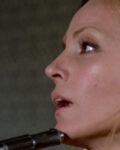Soundtrack Reviews: an Italian Octet
 I’m doing a set of soundtrack reviews in two parts, largely because I wanted to get the complicated one taken care of first, since it took a while to gather the specific components of this salute to Italian soundtracks.
I’m doing a set of soundtrack reviews in two parts, largely because I wanted to get the complicated one taken care of first, since it took a while to gather the specific components of this salute to Italian soundtracks.
Fans of giallo, zombie, cannibal, crime films, comedies, and certainly spaghetti westerns are well familiar with the whopping talent that produced an enormous amount of music when Italy was heavily riffing on whatever was hot during the sixties and seventies – my favourite period – and the eighties.
What’s unique about Italian cinema during that period is that while native writers, directors, and producers were making variants & knock-offs of whatever was a hit (home-grown, international, or imported from Hollywood), they never hired a Hollywood composer. (At least, I can’t think of one who was specifically involved in one of the aforementioned genres.)
Now, you could argue it was due to a sense of cost-effectiveness, or perhaps better for complex financing agreements, or maybe a Hollywood composer would’ve felt it was a step down to score a zombie flick, but the sheer volume of music released in Italy at the time of a film’s release is simply massive.
It may have been part of a film’s natural exploitation to issue a 45 single, an LP, or pack it together in some compilation release, but there was less / no stigma attached to not only hiring native composers, but releasing their music to the masses.
It’s also not a stretch to say that the work of Franco Micalizzi, Guido & Maurizio De Angelis, Armando Trovajoli, Stelvio Cipriani, Piero Umiliani, and Piero Piccioni were put on the same pedestal as Ennio Morricone – a giant whose C.V. included art films, epics, international co-productions, exploitive crap, and Tinto Brass erotica.
Vintage scores are still being reissued and remastered and expanded, although perhaps the runs of 500 copies simply allow indie labels to sell out of titles sooner, so there’s funds for the next venture.
The albums I’ve covered below are representative of the talent that moved back & forth between genres, sometimes with session musicians scoring films solo and becoming composers in their own right, and composers who decided to tackle some experimentalism as an antidote to the incessant sameness of another giallo, spaghetti western, or spy spoof.
Ennio Morricone is Italy’s modern Mozart, and perhaps more because he’s proven himself adept in any genre by being inventive, weird, and sometimes re-appropriating a theme or two now and then when a year’s quote runs as high as 20 film projects.
For a period, he was a member of the Nuova Consonanza [NC], an experimental group from which he explored and found a way to take strange sounds and give them some thematic form, like sputtering into a trumpet mouthpiece or having the musicians groan erotically into the microphones – sounds he later used in many giallo scores.
Some of the NC material is still available on CD, and Cometa Records have also released some material on LP, but their latest issue is Eroina [M] (1971), an album featuring previously unreleased weirdness that giallo fans will find oh-so-soothing. I’ve also added a review of the group’s second LP from 1967, Private Sea of Dreams [M], one of three platters reelased by RCA Victor; for those wanting more unreleased goodies, there’s also the multi-disc set Azioni [M], which die Schactel released in 2006.
Cometa’s also released Solisti di Armando Trojajoli [M], a 1968 album featuring music by the quartet I MARC 4. The group featured expert jazzmen known for performing other people’s music (like Trovajoli’s) and playing on numerous soundtracks, and among the personnel is Carlo Pes, a guitarist who had his own sporadic fling as a solo film composer.
In that regard, I’ve also reviewed Peppino De Luca’s L’uomo dagli occhi di ghiacchio (1971) and Pes’ Un uomo dalla pella dura (1972), both part of a double-bill CD [M] from GDM Records, with the former score performed by I MARC 4. Also reviewed is De Luca’s music from the 1970 production Dorian Gray [M] starring pouty Helmut Berger, which DigitMovies released a few years ago.
You could brand the selections in this week’s score roster as a kind of 3 degrees of separation (or something like that) where one soundtrack leads to another related composer, hence the related coverage. It’s also fair to say that Edda Dell’Orso was not one person but 18 clones created in a lab by Ennio Morricone’s producer to meet the demand of the composer without robbing Morricone of his favourite human voice.
Moving on, we have two of my favourites: Girogio Gaslini, and Piero Umiliani.
Gaslini’s work as a jazz pianist is beyond reproach, and Quartet Records released his debut film score for Michelangelo Antonioni’s La Notte [M] (1961) earlier last year, and they’ve just announced two new Gaslini scores on CD: La Sorelle (1969) and La Pacifista (1970). You may have heard Gaslini’s name as co-composer of Dario Argento’s Deep Red, but if you’ve never heard his jazz, you’re in for a treat.
Umiliani is best-known as the guy who wrote the “Mahna Mahna” song which Jim Henson brilliantly appropriated for several Muppets skits, but as a jazz composer, propagator of Italian lounge, and lover of the Hammond organ, Umiliani’s work is superb, and I’ve reviewed Una Bella Grinta / The Reckless [M] (1965) which Cinedelic released a few years ago.
Also reviewed is the snappy Africa To-Day [M] from Kronos Records, featuring African & Polynesian-flavoured library music Umiliani composed between 1971-1975. It’s an unusual sound that’s best described as exotica filtered through funked-up lounge sensibilities, and it works in its own trippy little way.
That CD, like many of the full stereo recordings of the period, are indicative of the amazing musicians and sound engineers who captured performances with such robustness. It may trace back to the jazz artists who wanted their performances to sound as intimate and rich as the Blue Note and Capitol LPs of their peers & idols, but what emerged during the late sixties & early seventies are recordings that to my ears are benchmarks of miking and engineering.
.
.
Mark R. Hasan, Editor
KQEK.com ( Main Site / Mobile Site )
Category: EDITOR'S BLOG, FILM MUSIC

















Connect